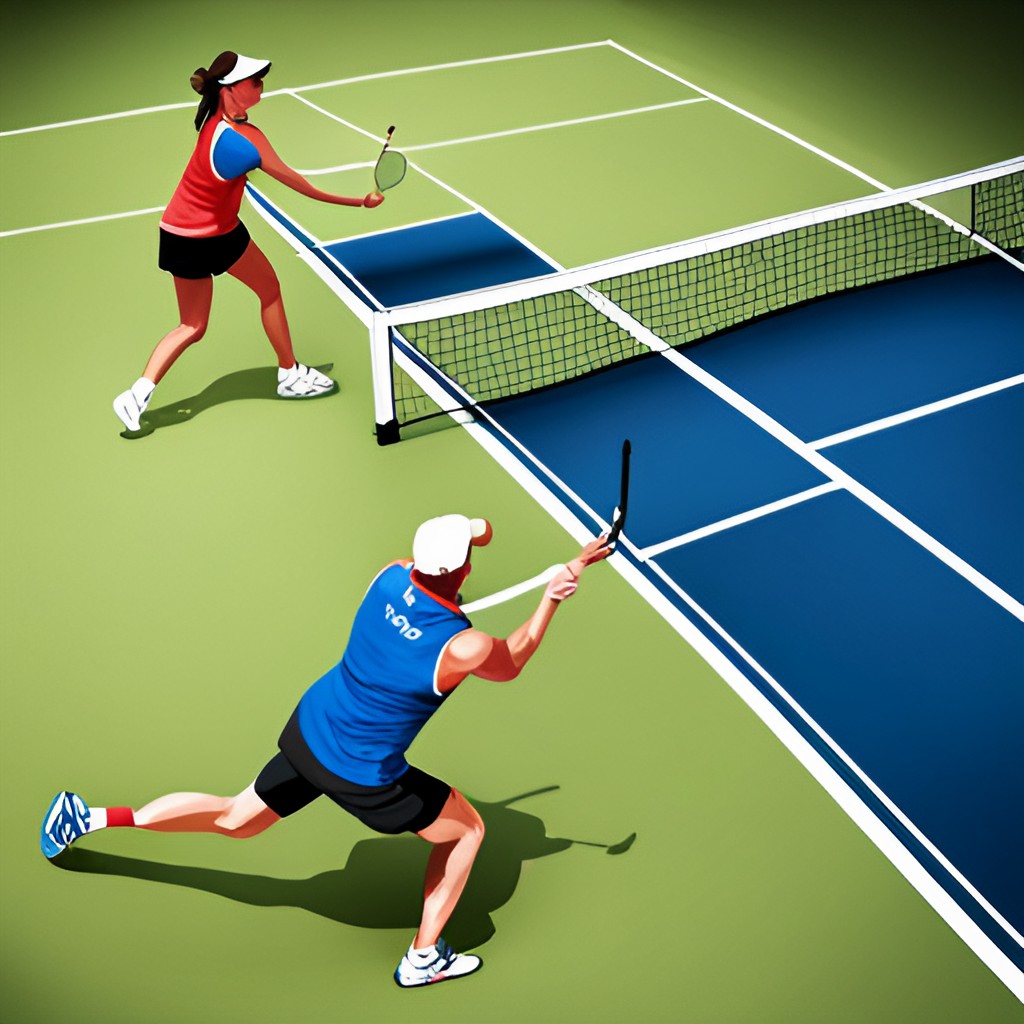A Complete Informative Article about Padel VS Pickleball In this blog, you will know the evaluation and how to play, so let’s compare Padel VS Pickleball.
Table of Contents
Introduction Approximately padel vs pickleball
Padel
Padel, a popular racquet sport played in a closed court, was certainly invented in Mexico in 1965 via Don Enrique Corcuera. This revolutionary recreation was born out of a preference to create a hobby that could be enjoyed by human beings of all ages and skill levels, combining factors from tennis and squash. the primary padel court was constructed by Corcuera as a scaled-down model of a traditional tennis courtroom, giving an upward push to a new and exciting sporting experience.
Pickleball A Short History of Its Origins on Bainbridge Island.
Pickleball, a famous racquet recreation that mixes elements of tennis, badminton, and desk tennis, was certainly invented on Bainbridge Island, Washington, in 1965 by Joel Pritchard, a congressman, and his buddies Bill Bell and Barney McCallum. The tale of its inception includes a handmade system and simple guidelines of play which have due to the fact advanced into the based recreation we realize nowadays.
Padel evaluation
- Ge.nesis of Padel: Padel originated in Acapulco, Mexico, with Enrique Corcuera envisioning a recreation that might be accessible to a broader target audience. Drawing suggestions from tennis and squash, Corcuera sought to lay out a game that changed into simpler to play and failed to require the same level of physical prowess as tennis.
- court creation and Dimensions: the first padel court built through Corcuera became smaller than a general tennis courtroom. the size is typically 20 meters in duration and 10 meters in width, enclosed via obvious partitions manufactured from glass or polycarbonate. those walls offer a unique feature of the game, allowing players to apply them to their gain at some stage in the match.
- Gameplay and policies: Padel shares similarities with tennis and squash. it is typically performed in doubles, with every group having players. The scoring is the same as tennis, with matches often performed in a nice-of-three units layout. The ball used is similar to a tennis ball but with less pressure, bearing in mind a slower game and longer rallies.
- Racquets and system: players use specially designed padel racquets, which can be strong and perforated to reduce wind resistance and aid management. The ball used is a chunk softer than a tennis ball, promoting a slower recreation and allowing gamers to apply spin with greater ease.
- developing recognition: After its inception in Mexico, padel won popularity rapidly and shortly spread to other components of Europe and the sector. Its accessibility, amusing gameplay, and the fact that it’s miles less difficult to study in comparison to tennis contributed to its full-size adoption.
- Padel nowadays: Padel is now an extensively diagnosed sport with a sturdy following in international locations like Spain, Argentina, Sweden, and the UK, amongst many others. It has even commenced to benefit traction in the U.S. and other elements of the world.
- expert Padel Circuits: the game has hooked up expert circuits and tournaments, which include the sector Padel tour (WPT), which are a magnet for pinnacle gamers and garner a sizeable viewership. those tournaments showcase the highest stage of padel play and are instrumental in popularizing the game.
- attraction and Accessibility: one of the key elements contributing to Padel’s reputation is its accessibility. it’s miles a game that humans of every age and ability range can enjoy, making it an incredible desire for households, buddies, and communities in search of a laugh and attractive bodily pastime.
- fitness blessings: Padel offers numerous health benefits, consisting of improved cardiovascular health, superior agility, better hand-eye coordination, and overall physical conditioning. moreover, the social nature of the game promotes intellectual well-being and a sense of community.
- future Outlook: The future of Padel seems promising, with increasing interest and funding in the game. As more human beings discover and fall in love with this exciting sport, padel will probably continue to amplify its worldwide footprint and emerge as a staple inside the global of racquet sports.
Evaluation of pickleball
- The beginning of an idea: In the summer season of 1965, Joel Pritchard and his own family had been looking for a way to entertain themselves. They wanted to play badminton but couldn’t locate the shuttlecock so they improvised and used a perforated plastic ball alternatively. To make the game extra available, they decreased the badminton internet and used paddles borrowed from table tennis. This impromptu recreation quickly became the muse of pickleball.
- The Inception on Bainbridge Island: Joel Pritchard and his friends, invoice Bell and Barney McCallum started out experimenting with their new game on a vintage badminton court docket in Pritchard’s backyard on Bainbridge Island. The homemade gadget, comprising paddles and a plastic ball with holes, allowed them to broaden a unique and enjoyable sport that mixed factors from diverse present games.
- The Naming of Pickleball: the game changed first of all named after the Pritchard family’s dog, Pickles, who became known for chasing the ball and hiding it within the trees. however, according to Barney McCallum, one of the co-creators, the name “pickleball” also alludes to the period “pickle boat,” a period in crew (rowing) wherein leftover oarsmen had been selected from different boats. using the phrase “pickle” became simply coincidental but fun, and it caught.
- Spread and reputation: After its inception, the game received popularity regionally on Bainbridge Island and quickly spread to other components of Washington and neighboring states. It was specifically appealing to households and older individuals due to its handy policies and the smaller court size in comparison to tennis.
- Formalizing the guidelines: As pickleball received traction, the founders and early lovers formalized the regulations of play, establishing a fashionable court docket size, net top, and scoring device. They worked to make the game extra constant and exciting for all gamers, which helped in its continued boom and popularity.
- Organized development: spotting the potential for pickleball as a leisure game, associations, and businesses started to shape promote, and standardize the game. The US Pickleball Association (USAPA) was set up in 1984, putting the degree for prepared play, tournaments, and the standardization of regulations.
- Modernization and Evolution: over time, pickleball has seen numerous changes and refinements in devices, regulations, and techniques. modern-day paddles at the moment are fabricated from excessive tech substances, and the game has ended up increasingly more competitive, attracting players of every age and ability level.
- Global expansion: Pickleball has now become a worldwide phenomenon, with a hastily growing community of gamers and enthusiasts no longer only in the United States of America but also in Canada, Europe, Asia, and the past. Tournaments and championships are held at numerous tiers, showcasing the sport’s evolution and competitiveness.
- Reputation and reputation: the game has gained popularity from country-wide sports activities agencies, and efforts are ongoing to establish worldwide requirements and promote pickleball’s inclusion in major sporting activities.
- Pickleballs have an impact on communities: Pickleball has become greater than only a recreation; it has grown to be a catalyst for building communities and promoting social interaction. The inclusive nature of the game, wherein humans of various awhile and skill stages can play collectively, fosters an experience of camaraderie and friendship. Many parks and leisure centers now offer pickleball centers, bringing people together and encouraging an energetic and healthy lifestyle. the sport’s emphasis on fun, workout, and social engagement makes it a favorite among groups, contributing to its considerable enchantment and continued growth.
Padel vs Pickleball.Padel Fastest-growing global racket sport. Pickleball: Quickest-growing in the US.
Padel vs pickleball is both rapidly gaining popularity in the international of racket sports, every experiencing an extensive boom in their respective areas. Padel is identified as the fastest-growing racket recreation on an international scale, at the same time as pickleball holds that identify within the US. allow us to delve into the motives behind the surging popularity of those sports activities and the elements contributing to their boom.
Padel: the worldwide Sensation
Padel, a racquet sport that originated in Mexico in the 1960s, has gained colossal traction worldwide in recent years. Its roots can be traced returned to an aggregate of tennis and squash, performed on a smaller court enclosed by glass and steel partitions. here are numerous reasons explaining why padel is taken into consideration the quickest-growing racket sport globally:
- Accessibility and ease of Play: Padel is surprisingly easy to choose for people of all ages and skill stages. The policies are less difficult than the ones of tennis, and the smaller court size makes it much less physically annoying, attracting a broader target market.
- Social enchantment: Padel is particularly social, encouraging players to engage in doubles matches. This social detail and the capability to have fun with buddies and a circle of relatives in the courtroom contribute to its good-sized enchantment.
- Adaptability: Padel may be played both interior and outdoors, making it a yr-spherical recreation in lots of climates. this adaptability allows for regular play and encourages human beings to take it up as an everyday recreational interest.
- Spectator-pleasant: The layout of padel courts, with glass partitions, makes it smooth for spectators to comply with the sport. This spectator-friendly issue enhances the sport’s enchantment and facilitates attracting a bigger fan base.
- Advertising and exposure: Padel has acquired considerable merchandising via global tournaments, television coverage, and social media. expert gamers, particularly from countries like Spain and Argentina, have contributed appreciably to increasing the game’s visibility and encouraging more people to attempt it.
- Community construction: Padel golf equipment and facilities are being hooked up at a growing fee globally, fostering a sense of network among gamers. that golf equipment offers organized leagues, tournaments, and social activities, creating a colorful padel network.
- Celebrities and Endorsements: The involvement of celebrities and athletes in selling padel has drastically boosted its reputation. high-profile endorsements and sponsorships have further brought the sport into the limelight.
Pickleball: united states of America’s Racket recreation Phenomenon
Pickleball, a sport that originated in the US in the Nineteen Sixties, is experiencing an unheard-of surge in reputation within the US. s .. it is a paddleball game that combines elements of tennis, badminton, and ping-pong, performed on a smaller court with a distinctive paddle and a perforated plastic ball. here are motives why pickleball is the fastest-growing racket game in the U.S.A.
- Age and Accessibility: Pickleball is particularly appealing to older people due to its notably low impact and less strenuous nature compared to sports activities like tennis. the convenience of play and quick getting-to-know curve make it handy to a vast range of age corporations.
- community Involvement: Pickleball is regularly played in community facilities, parks, and retirement communities, selling an experience of community amongst players. The camaraderie and social components of the sport are enormous participants in its growing popularity.
- health blessings: the game gives health blessings which include progressed cardiovascular health, more desirable hand-eye coordination, and increased mobility. those benefits attract people looking for a laugh and an engaging manner to live energetically and wholesomely.
- Inclusivity and flexibility: Pickleball is adaptable to various environments, consisting of indoor and outdoor courts. it could be played as singles or doubles, accommodating one-of-a-kind participant possibilities and ability stages, making it an inclusive game.
- promoting and boom Efforts: numerous agencies and enthusiasts actively promote pickleball through tournaments, exhibitions, and educational programs. those tasks assist in spreading attention, attracting new players, and fostering an aggressive spirit inside the game.
- academic institutions: Pickleball is increasingly being added in faculties and educational establishments, exposing more youthful generations to the game early on and developing a basis for a lifelong hobby.
- Media coverage: the sport has obtained growing media coverage, together with televised suits, highlighting distinguished gamers and foremost tournaments. This publicity has contributed to its increasing visibility and recognition.
Padel vs pickleball these are two distinct racket sports that vary not only in their rules and gameplay but also in their court dimensions, layout, and features. These differences contribute to the unique experiences players have in each sport. In this discussion, we will delve into the specific characteristics of padel and pickleball courts, emphasizing their designs and the impact these designs have on the gameplay and strategies of each game.
Frequently asked questions about Padel vs Pickleball
What is Padel?
Padel is a racket sport that combines elements of tennis and squash, played on an enclosed court smaller than a tennis court.
What is Pickleball?
Pickleball is a paddleball sport that incorporates elements of tennis, badminton, and table tennis, played on a smaller court with a lowered net.
How does the court size of Padel compare to Pickleball
Padel courts are larger than pickleball courts, resembling tennis courts in size, while pickleball courts are smaller, similar to a badminton court.
What equipment is used in Padel and Pickleball?
Padel is played with solid paddles and a tennis ball, while pickleball uses a paddle and a hollow ball, similar to a waffle ball.
Which sport is more popular globally: Padel vs Pickleball?
Padel is currently experiencing rapid global growth, expanding its popularity across continents. Pickleball, while growing, is most prominent in the United States.
How does the scoring system differ between Padel vs Pickleball?
Padel typically uses a tennis-like scoring system, while pickleball follows a unique scoring system, with points only scored by the serving team.
What are the key differences in gameplay between Padel and Pickleball?
Padel involves longer rallies and more strategy due to its larger court, while pickleball emphasizes quick reactions and agility with its smaller court and faster pace.
Which sport requires more physical exertion: Padel or Pickleball?
Padel generally demands more physical effort due to the larger court and longer rallies, involving more running and endurance compared to pickleball.
Is Padel or Pickleball more suitable for beginners?
Pickleball is often considered more beginner-friendly due to its simpler rules, smaller court, and slower-paced gameplay, making it easier for newcomers to learn and enjoy.
Can Padel and Pickleball be played indoors and outdoors?
Yes, both Padel and Pickleball can be played both indoors and outdoors, although indoor facilities are more common for Padel due to its larger court size.











2 thoughts on “Padel vs Pickleball Which is Your Perfect Game for Beach?”